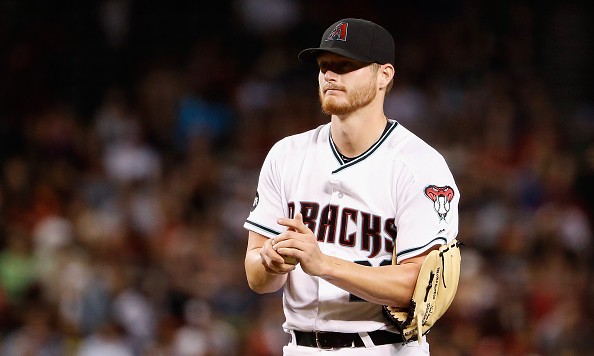The Arizona Diamondbacks have not had the type of year they envisioned back during the course of the winter. Those words have been written and stated verbally in some order and some fashion countless times as we approach the two-month mark of the season. While there’s still plenty of time to hope that they can recover, the Diamondbacks have already dug themselves into a hole with a slow start this season. The primary culprit of their 2016 woes? Pitching.
It was pitching that the club put such an emphasis on during the winter, as they signed Zack Greinke to an absurdly large contract and also paying a high price, in terms of prospects, to acquire Shelby Miller. Greinke got off to a slow start but appears to have trended back toward what we’ve come to expect from him. And while there are some problems with consistency in the rotation and the bullpen, the most notable issue with the pitching staff, as currently constructed, is that of Shelby Miller.
The Diamondbacks gave up Ender Inciarte along with two premium prospects, Aaron Blair and the most recent no. 1 overall pick Dansby Swanson, in order to acquire Miller from the Atlanta Braves. Blair has shown signs of becoming a solid rotation piece for Atlanta in the future, while Swanson has continued his success at the minor league level that began in the Diamondbacks organization last season. If things continue to trend as they have to this point, it could be an ugly scene for the legacy of Dave Stewart and this front office in Arizona.
The claim from the organization has been that Miller has been “pressing.” Whatever the issue is, it’s certainly resulted in some ugly numbers across the board for him. His ERA is an astronomical 7.09, up from a 3.02 mark last season. His FIP has jumped from 3.45 to 6.57. He’s striking out a career low 5.91 hitters per nine, while walking a career high 5.72 per nine. And by “career”, that’s taking his minor league time into account as well (with special exception to his walks, as he hit 6.00 in two rookie ball appearances back in 2009).
Opposing hitters have certainly loved facing Miller, and not only due to the fact that he isn’t striking them out and tending to walk them. They’re making hard contact 38.1% of the time (up almost a full 12%) and soft contact barely over 12%. Those are both the worst marks of his career as is his line drive rate, where opposing hitters are making line drive contact 22.7% of the time. The overall contact rate is up to 85.5% (up four percent from last year), while the swing rate, at 45.3%, is the second lowest of his career. He’s generating swinging strikes just 6.5% of the time, also a career worst.
The long and short of it is that Shelby Miller has been really bad. Opposing hitters are swinging at less and making more, and far better, contact than ever before. But while the Diamondbacks claim that Miller is pressing, is there an actual explanation for his woes this season?
Control is obviously a factor, as indicated by that alarmingly high walk rate. With Miller falling behind early in counts, he’s been having to rely on his four-seamer far more than usual, to the tune of a usage mark over 60%. Opposing hitters are going for a .286 average off of that pitch alone, along with a .198 ISO, indicating that he’s not only giving up contact, he’s surrendering really good contact.. Even without the slight dip in velocity, Miller doesn’t have the type of fastball that can overpower hitters. And when he has to rely on it to get back into counts, it’s getting pounded. Additionally, he’s been trying to incorporate a change, to more of an extent (though not too notable of one), and it’s been getting absolutely mashed, with a .375 ISO against. He just hasn’t been able to utilize the right mix of pitches in order to be effective.
One notable aspect is the lack of sinker usage. Miller’s use of that pitch flew up last season, over 20%. As a result, he was able to generate groundballs almost 48% of the time. And playing in front of a very capable Diamondbacks defensive infield, you’d think he’d want to continue that type of trend. But sinker usage has sunk back down to about two percent, and his GB% has fallen back down to an even 40.0%. The reason for that regression in sinker usage certainly is up for question. Miller established a trend that clearly worked for him in 2015 with that sinker utilization, but has since abandoned it. If that’s a large factor in his extreme regression this season, it not only stands to question Miller’s ability as a pitcher, but the way in which their coaching staff is operating in regard to Miller’s selection on the mound.
As far as a solution for Shelby Miller, there could certainly be mechanical issues worth exploring, as well as delving deeper into the reasoning behind his usage in particular situations. But the Diamondbacks are beginning to reach a point where they can’t wait for Miller to transition his way out of this funk in which he’s found himself.
**Usage Figures via Brooks Baseball
***Statistics via FanGraphs

